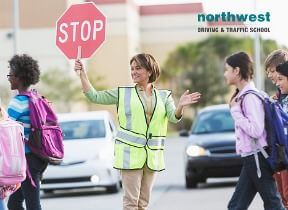- Traffic School
How to Perform an Emergency Stop

One of the most important driving lessons, and one that you will almost certainly be tested on in your driving test, is your ability to perform an emergency stop. In order to pass your test, you will need to demonstrate that you can perform an emergency stop when asked by your instructor and maintain control over your vehicle while you do it.
Given how important this maneuver is, both in real life and in terms of passing your driving test, we’ve put together a short guide to what an emergency stop is and how you go about performing one.
Table of Contents
What Precisely Is An Emergency Stop?
An emergency stop is a braking maneuver performed in response to hazards on the road that require you to stop suddenly. You might perform an emergency stop if someone or something suddenly crosses the road in front of you, if the car in front stops or stalls, if someone suddenly pulls out in front of you, or if you notice a significant environmental hazard on the road, such as a large pothole or something that might damage your car.
During your test, your examiner will ask you to pull over to the side of the road and they will then explain that you will now be performing an emergency stop somewhere on the road ahead. As you proceed, the examiner will raise their hand and you will need to bring the car to a standstill as fast as you can without losing control of the vehicle, exactly as if one of the hazards mentioned above had occurred.
How To Do An Emergency Stop
The AA suggests the following steps to performing a controlled emergency stop in a manual car:
- Stop without checking your mirrors: this will increase your stopping time and slow your reaction time
- Brake firmly but don’t slam your foot down on the pedal
- Put your clutch down just before you stop to prevent stalling
- Keep both hands on the wheel at all times to keep control and prepare for the next movement. In a real-life scenario, this might be moving the car in a different direction, for example
- Move away safely after checking all mirrors and blind spots
Stopping Distances
One of the keys things to bear in mind when considering an emergency stop is your stopping distances. Not only is stopping distance a part of your theory test but observing the correct stopping distance can save lives.
The RAC suggests using the following metric for calculating the correct stopping distance:
All you need to do is multiply the speed by intervals of 0.5, starting with 2. That’ll give you the stopping distance in feet, which is acceptable for the theory test. For example:
20mph x 2 = 40 feet
30mph x 2.5 = 75 feet
40mph x 3 = 120 feet
50mph x 3.5 = 175 feet
60mph x 4 = 240 feet
70mph x 4.5 = 315 feet
There are 3.3 feet in a meter, so divide the distance in feet by 3.3 to get the stopping distance in meters.
What To Do After An Emergency Stop?
Once you have performed an emergency stop, it is imperative that you check your mirrors and blind spots before pulling out again. Making an emergency stop will almost certainly result in disruption of the traffic behind you. This means that it is vital that you are aware of the position of other motorists, motorbikes, cyclists, and pedestrians before moving off. Due to your position in the road, a signal isn’t needed and may even be seen as misleading to other drivers.
Moving off without checking your mirrors and blind spots after an emergency stop will always result in your failing your driving test.
Why Do People Fail The Emergency Stop?
- Slow reactions
- Failing to stop fast enough
- Losing control and skidding
- Taking your hands off the wheel
- Using the handbrake before the car has stopped
- Failing to carry out checks and observations
Expert Training
The Northwest Driving School and Traffic School provides the Las Vegas community with live driving and traffic classes taught by seasoned instructors. All of our driving instructors have passed background checks, each automobile is DMV safety-approved and every member of the Northwest family is committed to providing excellent drivers ed and behind the wheel instruction.
At Northwest, you can expect to find outstanding classes, both on campus and behind the wheel, that are engaging, fact-filled, entertaining and geared toward success. We make no bones about it, we believe that Northwest provides the best driving lessons in Las Vegas, no matter your age or background. We are proud of the fact that 98% of our students pass their test on the first try. Call us at (702) 403-1592 to start your driving adventure with one of our expert instructors.
Written by:
Rich Heinrich
Master Instructor, Emeritus




